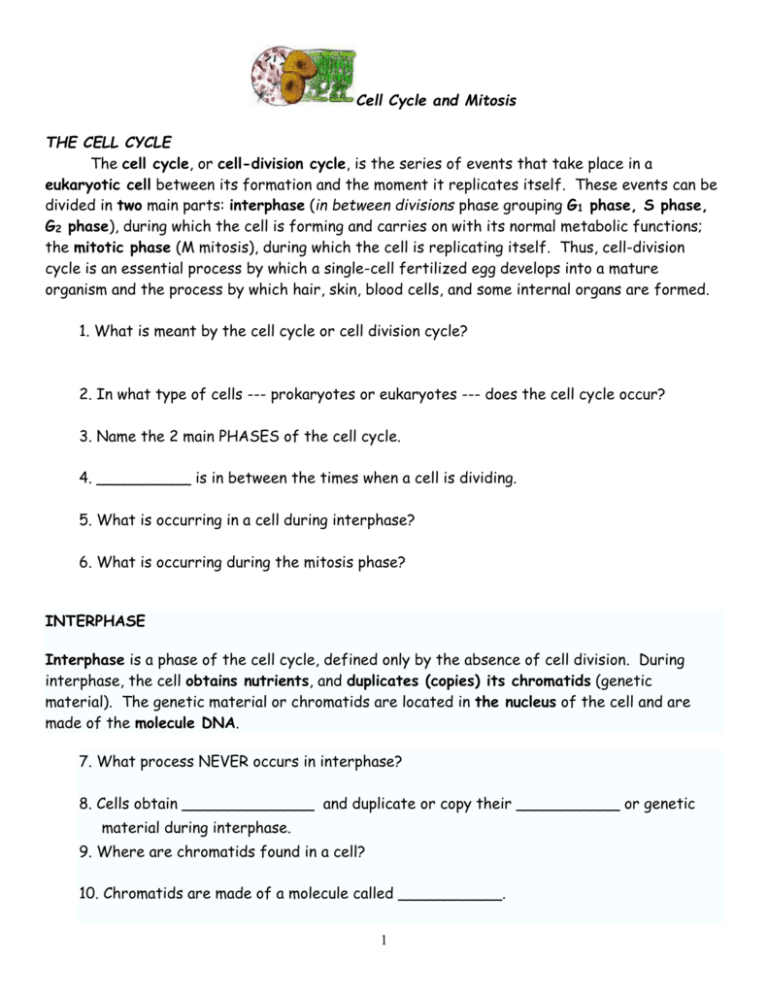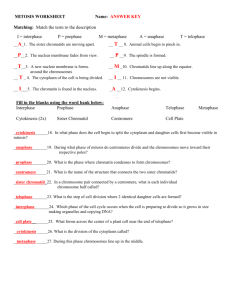Cell Cycle and Mitosis THE CELL CYCLE The cell cycle, or cell
advertisement

Cell Cycle and Mitosis THE CELL CYCLE The cell cycle, or cell-division cycle, is the series of events that take place in a eukaryotic cell between its formation and the moment it replicates itself. These events can be divided in two main parts: interphase (in between divisions phase grouping G1 phase, S phase, G2 phase), during which the cell is forming and carries on with its normal metabolic functions; the mitotic phase (M mitosis), during which the cell is replicating itself. Thus, cell-division cycle is an essential process by which a single-cell fertilized egg develops into a mature organism and the process by which hair, skin, blood cells, and some internal organs are formed. 1. What is meant by the cell cycle or cell division cycle? 2. In what type of cells --- prokaryotes or eukaryotes --- does the cell cycle occur? 3. Name the 2 main PHASES of the cell cycle. 4. __________ is in between the times when a cell is dividing. 5. What is occurring in a cell during interphase? 6. What is occurring during the mitosis phase? INTERPHASE Interphase is a phase of the cell cycle, defined only by the absence of cell division. During interphase, the cell obtains nutrients, and duplicates (copies) its chromatids (genetic material). The genetic material or chromatids are located in the nucleus of the cell and are made of the molecule DNA. 7. What process NEVER occurs in interphase? 8. Cells obtain ______________ and duplicate or copy their ___________ or genetic material during interphase. 9. Where are chromatids found in a cell? 10. Chromatids are made of a molecule called ___________. 1 Chromatids are connected by the centromere and have a LONG AND SHORT ARM. Label the parts of the chromosome including the long and short arms. 1. ___________________ 2. ___________________ 3. ___________________ 4. ___________________ Sometimes the cells exit the cell cycle (usually from G1 phase) and enter the G0 phase. In the G0 phase, cells are alive and metabolically active, but do not divide. In this phase cells do not copy their DNA and do not prepare for cell division. Many cells in the human body, including those in heart muscle, eyes, and brain are in the G0 phase. If these cells are damaged they cannot be replaced. 11.What happens to cells that enter the G0 stage? 12. Name 3 types of cells that enter the G0 phase when they are mature? 13. What happens if these cells are damaged during your lifetime? 2 MITOSIS– NUCLEAR DIVISION Mitosis is the process in which a eukaryotic cell (cell containing a nucleus) separates its already duplicated chromosomes (copied during interphase) into two sets of chromosomes so there will be two identical nuclei. It is generally followed by cytokinesis which divides the cytoplasm and cell membrane. This results in two identical cells (both have an identical set of chromosomes) with an equal distribution of organelles and other cellular components. The mitotic (M) phase and cytokinesis (C phase) together are called cell division, the division of the parent cell (original) into two daughter cells (new cells), each with the same genetic information (chromosomes) as the parent cell. Mitosis does NOT occur in prokaryotic cells that do NOT have a nucleus. In multicellular organisms, the somatic cells (body cells) undergo mitosis, while germ cells — cells destined to become sperm in males or ova (eggs) in females — divide by a related process called meiosis. Prokaryotic cells (bacteria), which lack a nucleus, divide by a process called binary fission. 14. When are chromosomes duplicated --- before or during mitosis? 15. What process follows mitosis? 16. The nucleus is divided during _____________, while cytoplasm of the cell is divided during _____________. 17. How do the two new cells compare with each other? 18. The two new cells are called _____________ cells. 19. Does mitosis occur in prokaryotes? Explain why or why not. 20. What process is used by bacteria to divide and reproduce? 21. Body cells are called ___________ cells, while reproductive cells are known as ____________ cells. The process of mitosis (division of the nucleus) is divided into four stages (Prophase, Metaphase, Anaphase, and Telophase). Immediately following nuclear division (mitosis), the cell membrane must also divide (cytokinesis). Animal cells divide the cytoplasm by constricting the cell membrane in the middle to form a cleavage furrow. Plant cells form a cell plate in the center to divide the cytoplasm. At Interphase, there is only one cell, but after cytokinesis there are two identical cells. 22. Name the 4 mitotic stages. 3 23. How does cytokinesis occur in an animal cell? 24. How does cytokinesis occur in a plant cell? During interphase, the genetic material is called chromatin and can NOT be clearly seen because it isn’t tightly coiled. When prophase begins, the DNA molecules are progressively shortened and condensed by coiling, to form visible chromosomes. Enzymes during prophase break down the nuclear membrane and nucleolus so they are no longer visible. Spindle fibers also form in prophase which will attach to the chromosomes. At metaphase, the spindle fibers attach themselves to the centromeres of the chromosomes and align the chromosomes at the equator (middle of the cell). Anaphase is the next stage. The spindle fibers shorten and the centromere splits separating the two sister chromatids. During telophase, the chromosomes pairs (chromatids are pulled to opposite poles of the cell. The nuclear envelope and nucleolus reform before the chromosomes uncoil. The spindle fibers disintegrate. 25. Genetic material is called ______________ during interphase and IS / IS NOT clearly visible. 26. What makes the chromosomes become visible during prophase? 27. What is used to help break down the nuclear membrane? 28. Besides the nucleus, what else is broken down during prophase? 29. What forms during prophase to LATER attach and move chromosomes? 30. Doubled chromosomes are held together by the _____________. 31. Where do chromosomes line up during metaphase? 32. During what stage are sister chromatids separated and moved to opposite ends of the cell? 33. Name 4 things that happen during telophase. a. b. c. d. 4 Name each numbered stage in the plant cell cycle diagram: (interphase, prophase, metaphase, anaphase, or telophase) 1. 7. 13. 2. 8. 14. 3. 9. 15. 4. 10. 16. 5. 11. 17. 6. 12. 18. Plant Cells in Mitosis 5 Label the stages of the cell cycle & mitosis. LABEL and COLOR the stages in the plant cell and animal cell. The stages should be colored as follows --- interphase-pink, prophase-light green, metaphase-red, anaphase-light blue, and telophase-yellow. Also label the CENTRIOLES, SPINDLE FIBERS, CENTROMERE, and CHROMOSOMES. 6







